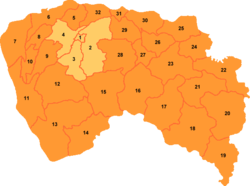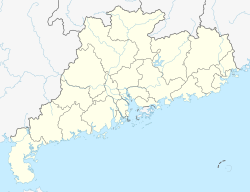Dongcheng Subdistrict (simplified Chinese: 东城街道; traditional Chinese: 東城街道; pinyin: Dongchéng Jiēdào) is one of the four subdistricts of Dongguan, Guangdong Province, China.
Dongcheng
东城街道 | |
|---|---|
 The government building in Dongcheng Subdistrict | |
 Dongcheng Subdistrict is labeled "2" on this map of Dongguan | |
| Coordinates: 23°01′41″N 113°47′00″E / 23.02806°N 113.78333°E | |
| Country | People's Republic of China |
| Province | Guangdong |
| Prefecture-level city | Dongguan |
| Area | |
• Total | 105.9 km2 (40.9 sq mi) |
| Population (2019)[1] | |
• Total | 500,000 |
| • Density | 4,700/km2 (12,000/sq mi) |
| • Hukou Population | 99,500 |
| GDP | |
| • Total | ¥ 58.656 billion (2019) |
| Time zone | UTC+8 (China Standard) |
| Postal code | 523129 |
| Website | dongcheng |
The subdistrict has an area of 105.9 square kilometers, and, as of 2019, has a permanent population of around 500,000, and a registered population of around 99,500.[1] Dongcheng Subdistrict's GDP as of 2019 is ¥58.656 billion.[2]
History
editIn 1958, Fucheng Commune (附城公社) was established.[3] The commune existed until 1983, when it was changed to a district.[3] The district was revoked in 1988 for Fucheng Subdistrict.[3] In March 2000, Dongguan renamed Fucheng Subdistrict to Dongcheng Subdistrict.[citation needed]
Administrative divisions
editDongcheng is divided into 23 residential communities and 2 living districts (生活区).[4]
Economy
editAs of 2019, the subdistrict's GDP was ¥58.656 billion, retail sales totaled ¥16.916 billion, fixed asset investment was ¥9.617 billion, international trade totaled ¥50.74 billion, and the subdistrict's tax revenue totaled ¥13.535 billion.[1]
Major enterprises with a presence within Dongcheng Subdistrict include Hsu Fu Chi, Rohm and Haas, Wanshida LCD (万士达液晶), CR Snow, Meiwei Circuits (美维电路), Guangrun Furniture (光润家具), Tecsun, and CYG Insulator Co. LTD (长园高能电气股份有限公司).[5]
Major retail and office centers within Dongcheng Subdistrict include Dongcheng Wanda Square (东城万达广场), Dongcheng Shibo Square (东城世博广场), Xinghe City (星河城), Junhao Business Center (君豪商业中心), and Yujing New Time Square (愉景新时代广场).[citation needed]
Transport
editRoad
editThere are four main highways in Dongcheng Subdistrict.[citation needed] Two expressways, the Dongguan-Shenzhen Expressway and the Guangzhou-Shenzhen Expressway, go through the Dongcheng Subdistrict.[citation needed] 16 buses go through the center of the Dongcheng Subdistrict.[citation needed]
Metro
editLine 2 of the Dongguan Rail Transit opened to the public on May 27, 2016, one of the four planned lines to be open as of 2020.[6] Four stations on Line 2 are located within Dongcheng Subdistrict: Qifeng Park, Dongcheng, Xiaqiao, and Lihua Park.
Line 2 is connected to the Guangzhou-Shenzhen-Hong Kong Express Rail and the Guangzhou-Dongguan-Shenzhen Intercity Rail via Humen Station.[7]
Dongcheng Subdistrict Metro Stations
| |||
Station name
English |
Station name
Hanzi |
Platform types
|
Transfer/connection
|
| Qifeng Park | 旗峰公园 | ||
| Dongcheng | 东城 | ||
| Xiaqiao | 下桥 | ||
| Liuhua Park | 榴花公园 | ||
Tourist attractions
editQifeng Park
editQifeng City Park (旗峰公园) is a prominent park in Dongguan, covering an area of 1,600 mu.[8] Well known attractions within the park include Huangqi Mountain (黄旗山), Huangqi Guanyin Temple (黄旗观音古庙), and the Huangqi Mountain lanterns.[8] The park is a popular hiking spot for residents of Dongguan.[8]
Huangqi Mountain rises 189 meters above sea level.[citation needed] Huangqi Guanyin Temple, which was built in the Song dynasty, is located at the foot of the hill.[8] During Chinese New Year and other major festivals, tourists come to the park to pray.[8] It is also tradition that people climb Huangqi Mountain during Chinese New Year.[citation needed]
The park is 800 meters away from the Qifeng Park Station, and is 1,800 meters away from Dongcheng Station.[8]
Huying Country Park
editHuying Country Park (虎英郊野公园), located in southeast Dongcheng Subdistrict and formerly known as Huying Tree Farm (虎英林场), is a large park covering an area of 2,979 mu.[9] The park, which opened at the end of 2000, is largely hilly and forested, with its highest point reaching 152 meters in altitude.[9] Popular attractions in the park include Huying Pavilion (虎英阁), Qingyou Gorge (清幽峡), the island within the lake (湖中岛), Yunyu Bridge (云雨桥), Roman Pillar Forest (罗马柱林), and Huanhu Road (环湖路).[9] Huying Country Park also contains the Shaokaochang Sculpture Park (烧烤尝雕塑公园), which has areas of sculptures devoted to important military and scientific figures.[9] Sculptures which depict other matters, like famous ancient and modern figures and animals, can be found scattered throughout the park.[9]
Liuhua Park
editThe Liuhua Park (榴花公园) was first built in the Ming dynasty, and it reopened in 1999.[citation needed] It has an area of 0.32 square kilometers,[citation needed] and is near the intersection of Guanlong Highway (莞龙公路) and Guanjie Highway (莞碣公路).[10] The park is open all day and has free admission.[citation needed] It is a key unit of Dongguan's cultural relics protection.[citation needed]
The primary tourist attraction in the Liuhua Park is the Liuhua Pagoda, which was built in the Ming dynasty.[10] In 1938, the first armed resistance to the Japanese occupation of China in Dongguan happened near the Liuhua Pagoda, and a memorial pavilion near the pagoda has been erected to commemorate it.[10]
Others attractions within the park include Honghua Temple, Huaxi Yintang, and Qiniang Lake.[citation needed]
Dongcheng Culture Square
editThe Dongcheng Culture Square (东城文化广场) is a multi-functional entertainment venue, is located on Dongcheng Road, with an area of 40,000 square meters.[citation needed] The complex including a 1,300-seat theatre, a gym, a library and an open-air music fountain.[citation needed]
Education
editNotable schools within Dongcheng Substrict include Dongcheng Junior Middle School (东城初级中学), Dongcheng No. 1 Middle School (东城第一中学), Dongcheng Lingnan School (东城岭南学校), Dongcheng Primary School (东城小学), Dongcheng No. 5 Primary School (东城第五小学), Primary School attached to Dongguan Normal University (东莞师范附属小学), and Dongguan Chaotian Experimental Primary School (东莞朝天实验小学).[citation needed]
Healthcare
editThere are 655 medical institutions in Dongcheng Subdistrict.[citation needed] The subdistrict's hospitals include Donghua Hospital attached to Sun Yat-sen University (中山大学附属东华医院), Dongcheng People's Hospital (东城人民医院), Dongguan No. 6 People's Hospital (东莞市第六人民医院), and Dongguan Taixin Hospital (东莞台心医院).[citation needed]
References
edit- ^ a b c d 东城概况 [Dongcheng Overview] (in Chinese). Dongguan City People's Government. 17 June 2020. Archived from the original on 21 July 2020. Retrieved 21 July 2020.
- ^ 2019年东城街道经济运行分析报告 (in Chinese). Dongguan City People's Government. 28 April 2020. Archived from the original on 21 July 2020. Retrieved 21 July 2020.
- ^ a b c 东城街道 [Dongcheng Subdistrict]. xzqh.org (in Chinese). 15 July 2011. Archived from the original on 21 July 2020. Retrieved 21 July 2020.
- ^ 2019年统计用区划代码和城乡划分代码 (in Chinese). National Bureau of Statistics of China. 2019. Archived from the original on 21 July 2020. Retrieved 21 July 2020.
- ^ 经济建设 (in Chinese). DongCheng Government. Archived from the original on 20 June 2015. Retrieved 21 July 2020.
- ^ 东莞轨道交通1号线破土动工 最快2022年底通车. Sina Guangdong (in Chinese). 29 September 2016. Archived from the original on 30 September 2016. Retrieved 21 July 2020.
- ^ "Dongguan Railway Line R2 to begin trial operations in 2015". Dongguan Today. 31 May 2012. Retrieved 29 November 2016.
- ^ a b c d e f 东莞旗峰公园 [Dongguan Qifeng Park]. mafengwo.cn (in Chinese). Archived from the original on 21 July 2020. Retrieved 21 July 2020.
- ^ a b c d e 东莞虎英郊野公园 [Dongguan Huying County Park]. mafengwo.com (in Chinese). Archived from the original on 21 July 2020. Retrieved 21 July 2020.
- ^ a b c 日军炮轰莞邑 军民奋起反抗. Nanfang Daily (in Chinese). 17 August 2015. Archived from the original on 21 July 2020. Retrieved 21 July 2020.
